Your online presence is crucial – do not take risks with your domain security. Letting 3rd party attacks or getting trapped into losing your account can be a nightmare and spell doom for your business’s infrastructure. Just imagine losing access to email, web, customer data, and a lot more if you depend a lot on your domain – which is the case with most businesses nowadays.
Cybersecurity is not confined to preventing DNS attacks, penetration tests, adopting social engineering practices and app security. Even if you have protected your website traffic using an SSL certificate, here are some key steps you need to take to secure your domain name against different kinds of cyberattacks.
Types Of Domain Name Attacks
Before we move on to the security tips, let us spend some time understanding different types of attacks that domain names are targeted with:
Registrar Account Hacking
Here, you lose control over your domain registration account, which means the attacker now has power over your domain names.
Domain Hijacking
An unauthorized domain transfer happens when someone moves your domain away from your registrar, using a bogus domain transfer authorization for your domain name (if it is not locked).
DNS Spoofing
DNS cache poisoning involves changing DNS records, which redirects your internet traffic to a malicious site.
Phishing And Spam
These two common network security threats can be attributed to the security features of your domain registrar.
Tips To Protect Your Domain Name
Now that you know the kinds of attacks that can be launched against your domain name, let us turn our attention to steps you can take to secure it.
1. Use 2-Factor Authorization (2FA)
Use a mechanism like Authy, Google Authentication, or a key-generator device (such as YubiKey) to make sure no one can get into your account even if they were to get hold of your domain registration account information.
2. Never Reuse Passwords
Most of us have been guilty of reusing the passwords or altering them slightly for different accounts as remembering all the passwords for our online accounts gets hard. Remember, convenience comes at a price, and this one can be really expensive – as is evident from multiple data breach episodes witnessed across the online services world.
3. Use Strong Passwords
Combine 8 chars or more to include both lowercase and uppercase letters, with a healthy mix of symbols and numbers – stay away from dictionary words.
You may create strong passwords manually, but it may get hard to remember them. We recommend the use of a good password manager such as Dashline or 1Password to generate random strong passwords and help save the credentials, so you are not burdened with memorizing them.
4. Enable DNSSEC
DNSSEC is a contemporary way to add additional cryptographic security to your DNS account. It protects your apps and DNS resolvers from 3rd party malicious manipulations (example, DNS cache hijacking).
However, this technology has not yet been adopted by all domain registrars – so, make sure yours offers support to check all requests against the crypto signature to prevent any unauthorized alterations.
5. Use WHOIS Protection Services
Not enabling WHOIS privacy while registering your domain initially means that crucial account details like your mailing address, email and phone number may be open to everyone on the internet. – and wouldn’t the hackers just love you for that!
To make things worse, automated tools like data-scraping agents are constantly being adopted by cybercriminals to scan WHOIS information over the internet and use the information they gather from your personal information to bombard with you with spam and even make you part of their phishing drives.
6. Lock Your Domain
Do not ignore this one, as it is something you can easily do while registering your domain name (or anytime after that). Verify that you change the status of your name to “Client Transfer Prohibited” or “Registrar Lock” – your registrar may use different verbiage to reflect this, but you must have gotten the idea.
Domain locking or placing a registrar lock offered by every domain registrar to help you safeguard your domain name from unauthorized transfers and alterations – which are the most frequent practices adopted by domain hijackers.
7. Verify Associated Email Address
Do not use an old email address (meaning one that you do not access frequently) for domain registration. If you end up losing this email account due to extended inactivity, it may become impossible to regain access to this email account – which may huge trouble for your domain name in the future.
8. Inform Your Domain Registrar Of Contact Information Changes
Make sure to keep your domain registrar updated with any changes to your contact information. You will need to verify personal details such as first name, last name, email address, phone number, driving license number, mailing address, etc. to establish your identity in the unfortunate event of your domain getting hijacked.
9. Turn Automatic Domain Renewal On
Bots scanning WHOIS information are always looking for domain names that are nearing expiry or have already expired – if you fall prey to one of these hackers, you may end up losing your domain name.
10. Counteract Cybersquatting
Cyber squatters illegally register domain names to make money by selling them in the future or use them for phishing activities. Registering common domain TLDs based on your domain name is an excellent way f preventing cybersquatting – for instance, if your domain is mydomain.com, register the corresponding .net, .org, .info, .tv, .io, etc. as well.
Also, explore misspelt combinations to prevent “domain typosquatting” from harming your business’ reputation as cybercriminals may use it for malicious activities.
Follow these 10 tips to secure your domain name. Adopting these measures will help you prevent domain hijacking and other related cybercrimes. Also, it will ensure your business’s online reputation and continuity are not affected by any service interruptions – which can happen for other reasons too. So, make sure you make these tips part of your security toolkit – which should also include things like SSL certificate, network security, backups, etc.



![Top 10 M4uFree Movie Alternatives | M4uFreeMovie in 2022 [Updated]](https://www.techsplashers.com/wp-content/uploads/2022/03/Top-10-M4uFree-Movie-Alternatives-M4uFreeMovie-in-2022-Updated.jpg)








Leave a Reply